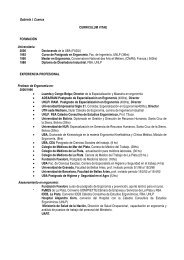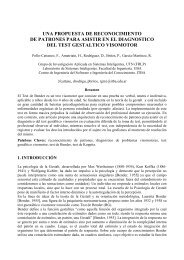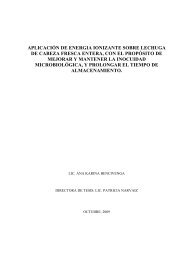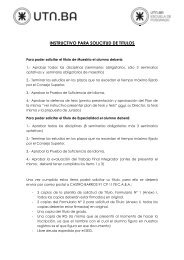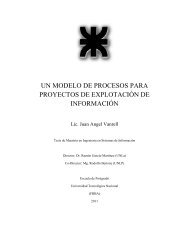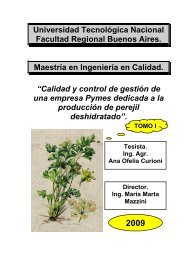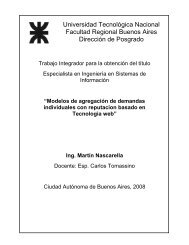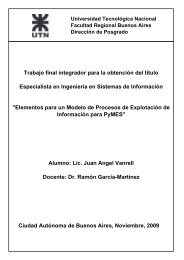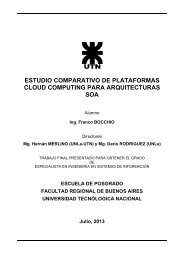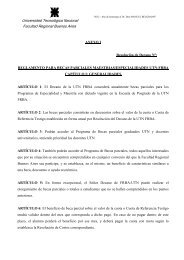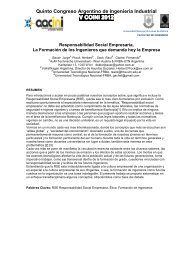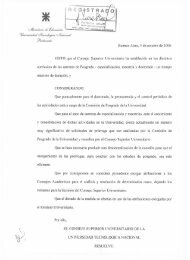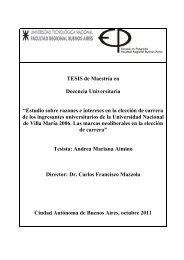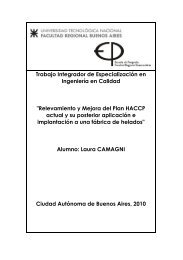desarrollo y validación de metodología para minimizar la ...
desarrollo y validación de metodología para minimizar la ...
desarrollo y validación de metodología para minimizar la ...
You also want an ePaper? Increase the reach of your titles
YUMPU automatically turns print PDFs into web optimized ePapers that Google loves.
Luego <strong>de</strong> obtener <strong>la</strong> recta <strong>de</strong> calibración, <strong>para</strong> <strong>de</strong>terminar <strong>la</strong> concentración <strong>de</strong><br />
<strong>la</strong> muestra analizada, se <strong>la</strong> mi<strong>de</strong> <strong>de</strong> manera repetida m (m>1) veces y su<br />
expresión estará dada por <strong>la</strong> expresión (3)<br />
x . y − x . y<br />
b = (1)<br />
S<br />
2<br />
X<br />
S e<br />
e2<br />
i<br />
=<br />
n − 2<br />
∑ (2)<br />
140<br />
Y0<br />
− a<br />
X 0 = (3)<br />
b<br />
A partir <strong>de</strong> aquí, <strong>para</strong> simplificar cálculos, se consi<strong>de</strong>ra <strong>la</strong> hipótesis que:<br />
● Las incertidumbres asociadas a los materiales <strong>de</strong> referencia <strong>de</strong> los<br />
estándares <strong>de</strong> calibración Ux son <strong>de</strong>spreciables frente a los otros factores <strong>de</strong><br />
incertidumbre Uy.<br />
Se <strong>de</strong>duce que el intervalo <strong>de</strong> incertidumbre expandida (1- α ) <strong>para</strong> x0<br />
(intervalo <strong>de</strong> predicción) a partir <strong>de</strong> <strong>la</strong>s siguiente expresions:<br />
2<br />
2 S e 1 1 ( x 0 − x )<br />
U ( x 0 ) = [ + +<br />
]<br />
2<br />
b m n<br />
2<br />
ns<br />
x<br />
2<br />
X<br />
Y − a<br />
b<br />
0<br />
0 = ± t n −2 α / 2<br />
S e<br />
⋅ ⋅<br />
b<br />
1 1 ( x 0 − x )<br />
+ +<br />
m n ns<br />
Este enfoque pue<strong>de</strong> ser el inicio <strong>de</strong> una serie <strong>de</strong> trabajos <strong>de</strong> aplicación a<br />
diferentes problemas, mas aún pudiendo verificar <strong>la</strong> hipótesis anterior,<br />
objetivo <strong>de</strong>l presente trabajo. Realizar un abordaje completo, combinando<br />
<strong>para</strong> tal fin todas <strong>la</strong>s fuentes <strong>de</strong> incertidumbre en un solo análisis utilizando<br />
datos <strong>de</strong> <strong>validación</strong> y ejercicios co<strong>la</strong>borativos, permitirá encarar con optimismo<br />
otros problemas <strong>de</strong> simi<strong>la</strong>r interpretación en <strong>la</strong> química analítica.<br />
2<br />
x<br />
19 20<br />
19 Kornblit, F.; Puglisi,C.; “Incertidumbre En Mediciones Químicas. Recta De Calibración”, INFOSIM<br />
n°8, 2002. http://portal.oas.org/linkclick.aspx?fileticket=uy27xwj4w1w%3d&tabid=584<br />
20 Nuevas consi<strong>de</strong>raciones sobre incertidumbres y recta <strong>de</strong> calibración en Química Analítica, Boletín<br />
informativo <strong>de</strong>l sistema interamericano <strong>de</strong> metrología – OEA, Querétara, México / Diciembre 2008. /<br />
http://www.sim metrologia.org.br/docs/revista__sim2008_20ene09.pdf<br />
2



